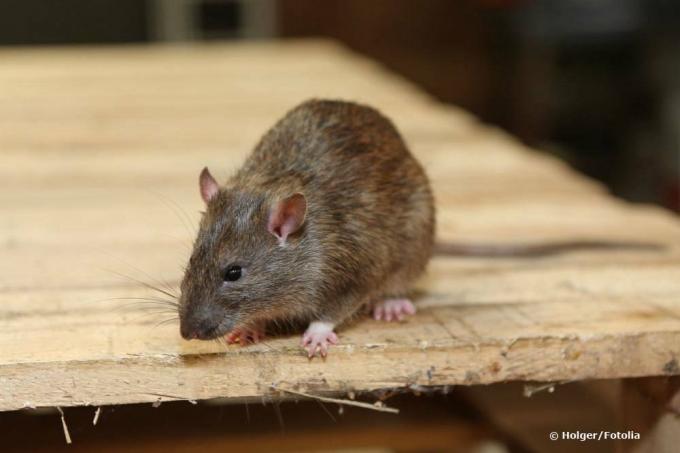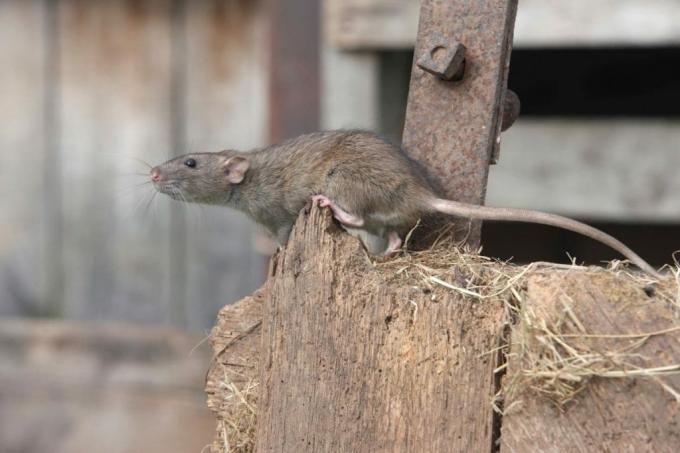
table of contents
- The difference between rats and mice
- The size
- The relations
- The physique
- The color of the fur
- The tail
- The footprints
- Residence and nesting cake
- Food and eating habits
- frequently asked Questions
Although rats and mice are very similar in many ways, they are two completely different animals. But how do you tell the difference between mice and rats? We explain the main features.
In a nutshell
- the biggest difference between rat and mouse lies in the size of the body and body parts
- Eating habits are a good way of recognizing the species even without individuals being present
- Especially in young rats, there is a high risk of confusion with mice because of numerous similarities
The difference between rats and mice
From obvious to only recognizable at second glance, numerous details paint a clear picture of when you have rats or mice in front of you. We're going from here Black rat (Rattus rattus) and the house mouse (Mus musculus), as these animals are most frequently encountered in the domestic environment. In addition, these two species show the greatest similarities and thus the possibility of confusion.

The size
The most obvious difference is probably the size of the animals:
- Mouse 3 to 10 centimeters long
- Rat: around 18 to 23 centimeters in length
When it comes to body size, the head-torso length is the starting point. In addition, there is the tail, which roughly makes up the length of the body in both species.
Note: If an adult mouse encounters a young rat, the almost identical size can actually quickly lead to confusion. Therefore, only the interaction of numerous features leads to clear identification!
The relations
Not only the absolute dimensions, but also the relationships between the individual body parts can serve as a clear distinguishing feature. Compared to the actual body, the head and paws are significantly larger in the mouse than in the rat.
The physique
Due to the difference in body size, the body structure of the animals is clearly different. The smaller mouse is usually much more compact and stocky than the slender, elongated house rat.

Note: A very well-fed rat can still appear stocky, while an emaciated mouse can look significantly slimmer than a normal rat. Therefore, this feature should always be considered in connection with the size and relation of the body parts to one another!
The color of the fur
Colors are usually a very good indication of whether you are looking at rats or mice:
- Mouse: light gray to brown coat color, mostly lighter belly
- Rat: Dark gray fur with a uniform color all around
The tail
Long, thin, mostly hairy tails in the mouse can be very clearly distinguished from the usually bare, scaly tails of the rat.

The footprints
The distinction between mouse and rat tracks can initially be made on the basis of the pure size. In addition, mice show themselves primarily as animals that step with full foot. The trace is therefore clearly and completely recognizable. Domestic rats, on the other hand, tend to walk on tiptoe. The prints are therefore incomplete. Often only the forefoot is clearly marked.
Residence and nesting cake
mouse
- Way of life close to the ground
- Building nests in caves, under sheds, floor slabs, etc.
- If necessary, it can also be climbed
rat
- No specialization in certain areas, today often found close to civilization
- Nest building especially under roofs, as well as in other places protected by height (in nature also on trees, high bushes etc.)
Food and eating habits
Even if rats and mice accept the same food, the preferences and the type of consumption differ significantly:
mouse
- prefers dry, starchy foods like cereals and other grains
- remove the husks of the grain and grind the endosperm with your teeth
- Foraging recurring in the same places
- no urgent need to drink water

rat
- prefers moist foods such as fruits, but also meat etc.
- Grain grains bite through, so that coarse residues remain recognizable
- Foraging in the area without recurring feeding spots
- drink approx. 30 milliliters of water per day
frequently asked Questions
In addition to the house rat, we mainly have the brown rat. With a body length of around 30 centimeters and a very dark, often almost black coat of paint, it is clearly distinguishable from the native species of mice at first glance. Finer distinguishing features are therefore hardly necessary any more.
A high fat content is typical of rat fur. When the animals crouch, crouch or sit up, the fur leaves clearly visible greasy smear marks on smooth surfaces.
It cannot be said in general which of the animals causes greater damage. Both species like to gnaw and leave behind easily recognizable damage to buildings and facilities when searching for food and building nests. Only the size and the location (cf. preferred whereabouts) allows conclusions to be drawn about the causative animal species.



